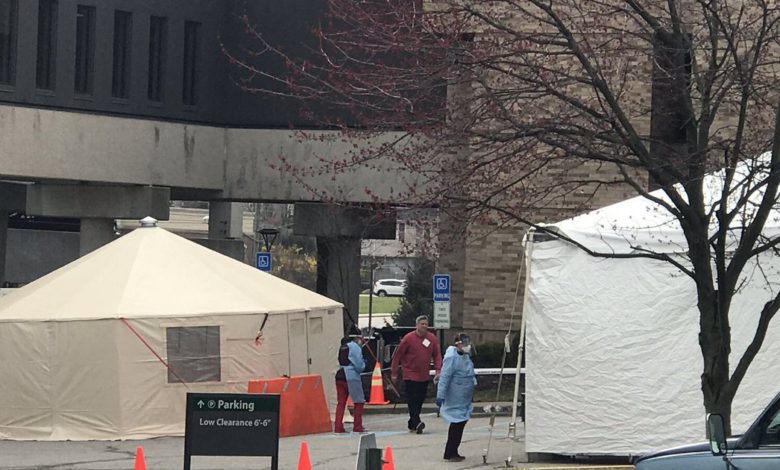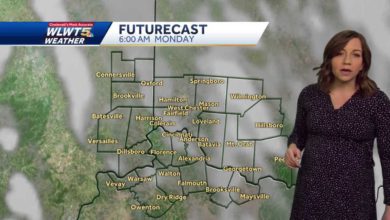
Editor’s note: With our coronavirus coverage, our goal is not to alarm you but to equip you with the information you need. We will try to keep things in context and focus on helping you make decisions. See a list of resources and frequently asked questions at the end of this story.
Cincinnati-area hospitals could start using new innovative technology that disinfects face masks for health care workers during the COVID-19 pandemic.
Hospitals everywhere are experiencing a shortage in N95 masks. Some doctors and nurses inside UC Medical Center told WCPO 9 News they can’t even get their hands on one.
That can change once area hospitals contact Columbus-based Battelle about their new technology.
“We know that it can kill spores and for sure it can kill influenza and SARS Co-V,” said Will Richter, Battelle Biologist and Principal Research Scientist
Battelle researchers created the machines.
Each machine can sterilize 80,000 N95 masks per day. Two machines are already operational in Columbus.
As of Monday afternoon, TriHealth, Mercy Health, Bons Secours Mercy Health, Cincinnati Children's, The Christ Hospital Health Network,
UC Health, Good Samaritan, and St. Elizabeth all know how to contract Battelle to sign up for the cleaning service, according to the Ohio Hospital Association.
Ohio Gov. Mike DeWine called the new technology a victory for health care workers.
"This is really important,” DeWine said. “The reason it's really important is we have to protect the people who are on the front line."
Here’s how the disinfecting process works:
Masks go into bags. Those bags go to onto trucks to Battelle in Columbus.
There the machines sanitize the masks with a hydrogen peroxide solution. It’s a day-long process.
A timeline for when this might start in our area isn’t clear yet, but the Ohio Hospital Association is working on a plan.
The FDA approved the new technology Sunday night but said only a Battelle worker can operate the machines.
“We are identifying individuals and training them that will be deployed with these systems to be able to operate them and to be able to have these systems running 24-7,” said Matt Zemanek, Division Manager of Battelle’s National Security business.
There are only five of these machines in the U.S. with one in New York City, another on the way to New York and one on the way to Seattle. Once they arrive, Battelle says it will take one to two days for them to become operational.
St. Elizabeth tells me it has plans to use the UV boxes in their patented EVS carts to sterilize the masks.
I’ve also asked about plans to use this new technology in southeast Indiana. I’m waiting to hear back from the Indiana Hospital Association.
Find more coronavirus/COVID-19 hotlines and resources below:
Ohio
- Department of Health COVID-19 hotline: 833-4-ASK-ODH
- See ODH’s COVID-19 resources here.
Kentucky
- State COVID-19 hotline: 1-800-722-5725
- See the Cabinet for Health and Family Services coronavirus resource site here.
Indiana
- SDH Epidemiology Resource Center: (317) 233-7125 or (317) 233-1325 after hours, or e-mail [email protected]
- See more information for coronavirus in Indiana here.
What is coronavirus, COVID-19?
According to the World Health Organization, coronaviruses are "a large family of viruses that cause illness ranging from the common cold to more severe diseases such as Middle East Respiratory Syndrome (MERS-CoV) and Severe Acute Respiratory Syndrome (SARS-CoV).
A novel coronavirus, such as COVID-19, is a new strain that has not been previously identified in humans.
COVID-19 was first identified in December 2019 in Wuhan City, Hubei Province, China and has now been detected in 37 locations across the globe, including in the U.S., according to the CDC.
The CDC reports the initial patients in China have some link to a large seafood and live animal market, indicative of animal-to-person spread. A growing number of patients, however, did not report exposure to animal markets, indicating the disease is spreading person-to-person.
What are the symptoms? How does it spread?
Confirmed cases of COVID-19 have ranged from mild symptoms to severe illness and death, according to the CDC. Symptoms can include fever, cough, shortness of breath.
The CDC said symptoms could appear in as few as two days or as long as 14 days after exposure. It is similar to the incubation period for MERS.
Spread of the virus is thought to be mainly from person-to-person. Spread is between people who are in close contact with one another (within about six feet). Spread occurs via respiratory droplets produced when an infected person coughs or sneezes. The droplets can land in the mouths or noses of people who are nearby or possibly be inhaled into the lungs.
According to the CDC, it could be possible for a person to get COVID-19 by touching a surface or object that has the virus on it and then touching their own mouth, nose or possibly their eyes. This is not thought to be the main way the virus spreads, the CDC said.
The disease is most contagious when people are the sickest and showing the most symptoms.








